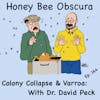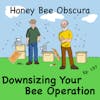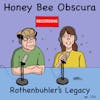Bee Beards - Part 2 (057)

In today’s episode, Kim and Jim continue their exploration of Bee Beards… though this time… they go big… really big bee beards you see in the movies, where they use 20 maybe 30 pounds of bees, and the person is covered from the top of his head...
 In today’s episode, Kim and Jim continue their exploration of Bee Beards… though this time… they go big… really big bee beards you see in the movies, where they use 20 maybe 30 pounds of bees, and the person is covered from the top of his head to his shoe laces? How can they do that?
In today’s episode, Kim and Jim continue their exploration of Bee Beards… though this time… they go big… really big bee beards you see in the movies, where they use 20 maybe 30 pounds of bees, and the person is covered from the top of his head to his shoe laces? How can they do that?
You have to start with that many bees that have been queenless for up to a couple three days. Queenless packages work well here.
Then, you put them all in one big box, and using a piece of screen, with Vaseline smeared on it and artificial queen substance at the top, you dip that screen into the box, and the bees crawl up onto the screen.
Of course, you need a person willing to do this. They daub queen pheromone on his body, and the screen is moved next to him and the bees crawl onto that person. Simple as 1, 2, 3. Right?
Well, not quite that simple. There's a fourth step...You have to get them off when this is over and you have to figure out what to do with them then.
Listen in and learn how all this works from a couple of guys who have been there and done that. You’ll probably never do one, but being aware of the biology at work will make you a better beekeeper.
___________________
We welcome Betterbee as sponsor of today's episode. BetterBee’s mission is to support every beekeeper with excellent customer  service, continued education and quality equipment. From their colorful and informative catalog to their support of beekeeper educational activities, including this podcast series, BetterBee truly is Beekeepers Serving Beekeepers. See for yourself at www.betterbee.com
service, continued education and quality equipment. From their colorful and informative catalog to their support of beekeeper educational activities, including this podcast series, BetterBee truly is Beekeepers Serving Beekeepers. See for yourself at www.betterbee.com
______________________
Honey Bee Obscura is brought to you by Growing Planet Media, LLC, the home of Beekeeping Today Podcast.
Music: Heart & Soul by Gyom, Walking in Paris by Studio Le Bus, original guitar music by Jeffrey Ott
Copyright © 2022 by Growing Planet Media, LLC

Episode 57 – Bee Beards, Part 2
[music]
Jim: Kim, a few days ago, we talked about bee beards - the small version of bee beards. There are bigger versions of bee beards used in movies and places like that.
Kim: Yes, I've seen some of those. In fact, I've been in part of some of those. Basically, the biology is the same, but the technique is way, way different.
Jim: Well, what I'd like to do, if it's okay with you, is pick up where we left off before on exactly how do you grow to be the “big bee beard guy.” Hi, I'm Jim Tew.
Kim: And I'm Kim Flottum.
Jim: We're at Honey Bee Obscura where, for some reason not known to anyone, but Kim and me, we're talking about bee beards.
Introduction: You are listening to Honey Bee Obscura, brought to you by growing Planet Media, the folks behind Beekeeping Today podcast. Each week on Honey Bee Obscura, hosts, Kim Flottum and Jim Tew, explore the complexities, the beauty, the fun, and the challenges of managing honeybees in today's world and engaging in an informative discussion meant for all beekeepers, long-timers, and those just starting their journey with bees. Sit back and enjoy the next several minutes as Kim and Jim explore all things honey bees.
Jim: This is a significant undertaking, though. This is bee biology to the extreme to handle these things. There are all kinds of variations on this bee beard theme as it grows larger and larger.
Kim: Yes. When we were talking before, we were talking about three pounds of bees a package, and that's enough to cover your chin and your neck a little bit and up your cheeks. That's a good demonstration for people who aren't real familiar with this, but when you get some of these bigger things, where they're using 20 or 30 pounds of bees to cover you from head to toe, that's a whole different animal.
Jim: What seemed to have started that several years ago was Guinness and his record book, everybody wanted to be in the Guinness Record Book. I don't say everybody, a lot of beekeepers wanted to be in the Guinness World Record Book for the largest bee beard, and so they were putting on crazy pounds of bees on themselves, covering their entire body with these things.
Kim: Well, there's that, and then there was the flush of bee attention when Africanized bees came to the US, and that too got a lot of attention.
Jim: Yes. That's interesting. We said in the first episode, and it should be said again, that there's a good time and a bad time to have and be doing bee beards. You need to really know what you're doing because if this thing goes wrong and you're in the public domain, it can really not be a positive moment there for beekeeping. You really, really need to know what you're doing and have a stone-cold plan before you take these things on.
Kim: Yes. Like I said before, the biology of 30 pounds of bees and 3 pounds of bees is a lot more similar than not. If you pay attention to the details, I think you can probably do one of these. I've seen them done and everybody that did them still is around today.
Jim: Yes. That's true. Let's talk about the man who has done this the most all throughout the years and has made movies and has really been in the forefront of using bee biology. In many cases, Kim, Norman Gary has worked out novel situations, novel devices for doing this. Let's talk about this piece of screen, that eight mesh hardware cloth. You've seen him use it, I have not.
Kim: Yes. Back up a half a step. Just like a small bee beard, you got to collect some bees. They got to be queenless and they've got to be in a container. You can do this any number of ways. When I was with Norman, he did this bee beard or bee suit, wasn't beard, bee suit. What they did is they took some queenless packages and they shook 10 of them into a big box, and then they closed the box, and the box was then transported close to where they were going to do the beard. These screens that you mentioned, they had about 18 by, I don't know, 8 or 9, something like that.
Jim: Kim, the exact dimensions of that bee screen are in ABC and XYZ, the new addition, he's got the whole procedure worked out there.
Kim: Something I didn't catch when I saw that, you mentioned that he puts Vaseline on these screens.
Jim: He does, there's a light layer of Vaseline. He wanted that, he said, because when he used this dustpan to collect the bees off very gently to pile them onto the bee beard site, he wanted the bees to slide off gently.
Kim: Oh, that makes sense.
Jim: He also, once as we're on the Vaseline thing, let me put this out there, Dr. Gary also said that he would like to put out a light film of Vaseline on the funnel when they were shaking the bees off to start this whole process to keep the bees slightly slippery and slippery amongst themselves.
Kim: That makes sense. Of course, you're feeding them all of the time, spray sugar syrup solutions. [crosstalk]
Jim: We need can't say that enough, these need to be well-fed, full bees.
Kim: Fat and happy and not at all cantankerous. Fat and happy and slippery.
Jim: I want you to keep talking about this screen because I think it may have use outside of the bee beard business. Go ahead.
Kim: Well, the way I saw it, then this box is opened. On this screen, depending on how you're doing this is either caged queens, because you're dealing with queenless bees, or artificial queen pheromone, either one work. If you got access to pheromone, then you're not going to endanger queens, but if you don't, you put a couple of queens on the top of each one of these screens, which you're holding the screen by a rope from the top. You dip it into the box, it's got queens or queen pheromone, and the bees in the box go, "We're home, here's the queen," and they just crawl up on this screen. When the screen is as full as you want it, you can move it. You can just, using that rope, pick it up and carry it to where you want it, to where the bee beard is going to be actually because you're probably 8 or 10 feet from where the person is who's going to wear this.
Jim: Yes. I can add a few picky details to this. The screen had a simple wire handle on it that you made from a piece of common electrical wire. In fact, Dr. Gary specifically said 12 gauge wire. You had a nice, neat handle on it. It was just, I'm going to say again, it was just a piece of eight mesh hardware cloth that was about 9 or 10 inch is wide and about 18 inches long. Then you carry around this thing loaded with bees like you would almost carry a five-gallon bucket.
Kim: Yes. That wire handle keeps it from swinging probably, than the one with a rope handle. That makes sense.
Jim: Well, that was where I'm going. Hey beekeepers listening, how could we use that? Does that have any value? This piece of eight mesh hardware cloth with a queen on it in a cage? In my case, I don't have access readily to queen pheromone. Would that be helpful in some instances for hiving a swarm, for moving bees, for making splits? I don't know. It's a technique I've never used before. Apparently, Dr. Gary only used it in his bee beard business, but I was completely intrigued when I read this procedure. I'm finished, Kim, with that. I've made my point. Let's get back to the big bee beard business.
Kim: Well, you've got these screens, you've dipped them into the box, and you've gotten as many bees out of that box using 2, 3, 4, 5 of these screens as you can get. Then you take them over to the person who is sitting, and that person has done some preliminary work too. Depending on how you are doing this, you've either got a bunch of queens strapped you like you do in that small one, or you're using that artificial queen pheromone and you've bathed in that.
I've seen it done both ways and the artificial queen pheromone seems to go a little smoother because you can put that everywhere where you've just got queens, you've got them on the top of your head and under your chin and on your chest and wherever. The pheromone, and the way I saw it worked was a cotton ball was soaked in that thing and it was just dabbed in two or three places, and then some more was soaked and dabbed in two or three places.
You had it in a lot of places right on your body, and then you would bring the screen over, and I saw them do it two ways, one at a time or two at a time from each side. You would hold the screen next to the person who was going to get the bees eventually, and the bees would crawl off the screen onto that person and begin to gather on the spots that had been dabbed with artificial queen. I've seen people completely cover their face with their eyes closed and their nostrils and ears full of cotton.
Jim: They had their own reasons for doing this, didn't they, Kim, because I can't think of one right now, but if you had a reason for wanting that done, here's how you would do it. Of course, Gary was doing it in many cases because of some movie lines, some movie plots, some movie purpose, but the rest of us are probably just playing at a bee meeting or something.
Kim: I saw him do it for a TV show long ago called Stan Lee's Superhumans. I was there when he did that. Then it's a matter of evening out all of the bees, you're going to find them, I'm going to say clustered, but gathered denser on those spots with queen pheromone and the spots between them. Then you just even them out. You can use a credit card, the bee brush works, something that's gentle and not going to bother the bees, and you're feeding them.
Jim: You keep saying that. It’s clearly important, isn't it?
Kim: [chuckles] You're spraying them. You're feeding them. You want fat happy bees there. Then you get to the point where you've got as many bees on you, and you've got them as many as you want, and the camera's clicked, and the movie camera goes on. Then what?
Jim: Well, I'll tell you. While everyone is getting their pictures right now and getting the moment recorded, let's take a short break to hear from the company who helps us to pay the bills.
Kim: Good idea.
BetterBee: Betterbee is pleased to sponsor today's episode of Honey Bee Obscura podcast. For over 40 years, Betterbee has supplied beekeepers across the country with the tools, equipment, and knowledge needed to succeed. Because many Betterbee employees are beekeepers themselves, they understand your needs and challenges and are better prepared to answer your beekeeping questions. From their colorful catalogs to their supportive beekeeper educational activities including this podcast, Betterbee truly lives up to their tagline of "beekeeper serving beekeepers". See for yourself at betterbee.com.
Jim: Okay, Kim. After you've got these bees on, I mean, you got your face covered or whatever you've done, then that's the same situation that it was with the small bee beard. How are you going to get them off? In essence, it's a very similar situation. You bounce them off, you bang yourself, right?
Kim: With this many bees, you're not in a cage, you're probably outside. When I saw it done, I was in the middle of an almond orchard, believe it or not. What they did for this one was Norm was standing on a canvas. He's sitting on a chair, and then when he stood up, people were taking all the pictures, and then it was done. What Norm would do was he would get his assistants on each corner of the canvas, and then he would jump as high as he could jump and land on the canvas. 95% of those bees would be jarred off from his body.
Jim: Yes, because of the weight of them.
Kim: Right. Then as soon as he landed, he stepped off that canvas, and the people picked up the four corners in the middle and they just brought them together. He grabbed a stool that he was sitting on and they brought up, and they went over, they gathered probably 75%, 80% of the bees were right on that canvas right now. Some of them were starting to fly. They took them over to that box with the screens in and the queen pheromone that was on those screens, and they dumped them in there, and because of the queen pheromone, they said, "Hey, we're home. Life is good." Then Norm would go over to the box and jump one more time. He usually walked away bee-free.
Jim: I would've thought that the queen pheromone on him would have made him still attractive until he left the building as it were.
Kim: There was that and he was, but he jumped them off. When he jumped, they fell into a stronger bee queen pheromone zone, I guess you'd call it.
Jim: Yes, yes, yes.
Kim: I don't want to have to fly to go to mom, I'm going to stay right here because it's stronger, and it seemed to work.
Jim: It has been many instances, I'm always-- beekeeping is really popular now and has been popular for a number of years, and it's not uncommon to see bee segments in a movie. At the end, that's always intriguing to see who the bee wrangler was, who kept them under control, who had secret chemicals and pheromone to get make bees do these things. I'm thinking, I wish I could do that, but in reality, I don't wish I could do that.
Kim: I like watching.
Jim: Years ago, there was a variation on a theme at the Eastern Apiculture Society. They would use this concept of bee bearding but not on a human. They would put them on stakes in the ground that were probably 5 feet tall. Then they would show the biological activity while the bees would move from one stake to the other, and you could relocate the swarm.
Instead of doing it as a bee beard on a person, they were essentially making a bee beard swarm on a stand, and then making that swarm move to the other stand and using it as a teachable moment for how these pheromones worked, how the queens were attractive and whatever. There’re all kinds of ways, all kinds of techniques, all kinds of reasons that people may have for wanting to have this bee beard, bee swarm concept that they manage.
Kim: I'm more than willing to watch. [laughs]
Jim: Yes. That has always been my theme too. Can I be the guy with the microphone who's at a safe distance talking you through this? Well, I don't plan on wearing a bee beard, Kim, and I'm clean shaven and you're not. I guess it should be said that most people who wear bee beards have to be clean-shaven. Even though I could, I'm not, unless you shave, I don't see you doing it.
Kim: No, no, but like I said, I like to watch. For people who are interested in doing this for whatever reason, there's good, safe ways to do this. You can impress people that are listening, and while you're doing it, you've got somebody like you talking outside the cage telling people that are watching what's going on, why it's happening, why this is important in bee behavior, why it's important in honeybee survival. People are worried about bees and beekeeping, and here is a piece of beekeeping that they can observe, and you can inform them about.
Jim: Just make sure it's a positive event because when you're dealing with the public and you got these in the public, don't just have one doomsday plan, have two or three doomsday plans.
Kim: There you go. Good idea.
Jim: All right. What else do you want to add, Kim?
Kim: Well, only two things. One is I think we've covered bee beards as much as we can cover them without actually doing one. The other half is if there's something on this show that you liked listening to today, share it with a friend. If you got somebody that you think might want to help you do a bee beard, let them listen to this and give him some background information, and then take a look at ABC.
Jim: I like all those things, take a look at ABC for a whole list of reasons.
Kim: There you go.
Jim: Thank you, Kim. I enjoy talking to you.
Kim: Next time.
Jim: Why don't you wear a bee beard this the summer? I'll photograph it and I'll use the microphone outside and talk to you through it.
Kim: I'm just going to think about that. [chuckles]
Jim: Yes, you think about it.
Kim: Take it easy.
Jim: Bye-bye.
[00:17:48] [END OF AUDIO]
New to Honey Bee Obscura Podcast?
Here are some great episodes to start with. Or, check out episodes by topic.













